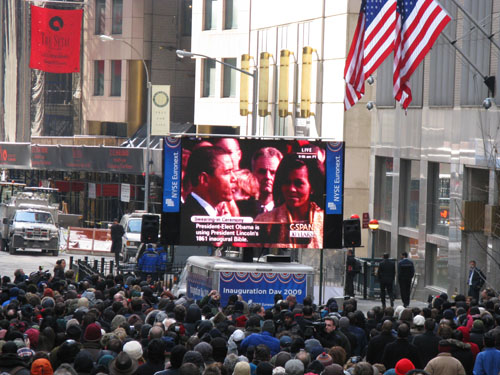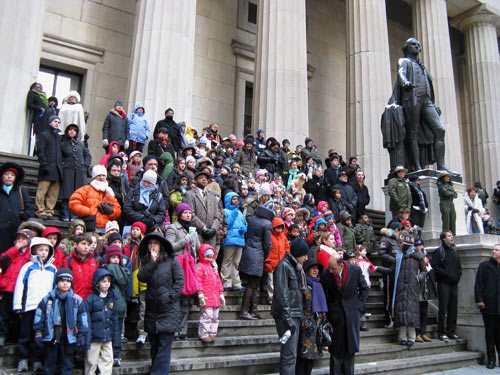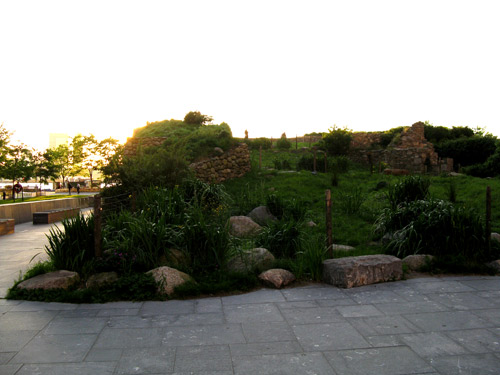Category: NYC History
44
Yes, it still felt good the morning after, and even still a month and a half later when it seemed the entire city paused on a cold and bright January morning to revel once again in this historic moment.
Obama’s inauguration was broadcast on screens large and small throughout the five boroughs. In the Financial District, productivity plummeted (and Internet connections slowed) around 11:30AM as workers put aside their work to watch the event on their computers or office television sets. I made my way to the Jumbotron screen set up outside the New York Stock Exchange where the crowds were quickly building, arriving just in time to hear a sparkly bow-topped Aretha Franklin belt out “My Country, Tis of Thee” before Joe Biden’s swearing in by Justice John Paul Stevens.
Several hundred people filled Broad Street despite the freezing temperatures — though no comparison to the crowds that were shown at the Mall in DC. Crowd estimates there varied wildly from 1.5 million to 4 million — though most of the time, the figures are almost entirely made up anyway; the Associated Press stayed conservative with their report of “more than 1M“. I believe it.

The musical selection lead-in was by John Williams with snippets of familiar melody lifted from the traditional Shaker hymn “Simple Gifts,” which Aaron Copland also famously borrowed for his “Appalachian Spring“. The tune broadcasts Inspiration, capital I, especially when rendered by Itzhak Perlman and Obama’s favorite cellist Yo-Yo Ma. Even if the music was pre-recorded.
And then, the moment we were all there to witness: Barack Hussein Obama taking the Oath of Office:

The assembled crowd cheered riotously, among them several dozen schoolchildren in homemade Obama headgear, who had gathered with us on the steps of Federal Hall.


Our new president delivered a measured, somber speech on this jubilant day, one which garnered generally favorable reviews. I did appreciate the nod to American songwriter Jerome Kern (at 1:03) — and yes, friends, this song was written in 1936, but it’s a standard, and it was performed by Fred Astaire and Ginger Rogers, so therefore not so strange that I recognized the reference… geez!
Check out the full NYSE Inauguration simulcast Flickr set here.
…to the shores of wine country
High fuel prices may be forcing most of the antique sellers online; we trekked the entire 50 miles of the sale without coming across a single dealer. But while Route 90 wasn’t the cornucopia of collectibles we’d envisioned, the entire weekend didn’t have to be a bust.
We decided to pack in early after a head-scratching encounter with one local woman and her chicken coop, during which we received some serious misinformation about the normal egg laying schedule of hens. (6 eggs a day? We may be city folk, but we’re not that gullible.)
The eastern shore of Cayuga Lake hosts just two active wineries compared to over a dozen along the western edge. Although we were given (more) dubious information about how the Cayuga County-side farmers historically have been less willing to sell their land for use as vineyards, a more probable explanation for the discrepancy is the west-to-east moving jet stream which creates a warmer (and somewhat less vine-friendly) eastern lake coast.
We stopped in for a tasting at 72-acre Long Point Winery in Aurora — the second winery to open its doors on the eastern side of Cayuga Lake, in May 2000. (King Ferry Winery was the pioneer, in 1984.)
After picking up several bottles of the whites for which the Finger Lakes region is best known, we moved on, bidding adieu to Route 90. Continuing on the scenic route home, at Ithaca’s Six Mile Creek Vineyard, we sampled and bought more award winning Riesling. That afternoon, the tasting room overlooking the sloping vine-covered hills was also hosting half a dozen greyhounds and their owners, who were at the winery for the Grapehound Wine Tour — an annual Finger Lakes hound/wine tasting event, now in its third year.
From the wine trail to the ice cream trail…
Some places are worth a stop, just because you like the looks of them. Richford’s Dairy Treat caught our eye as we made the turn onto Route 79, with its hulking black smoker parked in the front lot, and huge signs advertising BBQ chicken and 24 flavors of soft serve ice cream — mixed to order.
My creamy espresso cone did not disappoint.
A piece of Ireland
It feels good to be home.
To kick off the summer’s River to River Festival, soprano Leah Partridge and tenor Norman Reinhardt performed an evening of operatic arias and duets in Battery Park City’s South Cove.
On my way to the outdoor music recital, I walked by the Irish Hunger Memorial — a striking 1/4 acre plot of land nestled anachronistically among the lower Manhattan skyscrapers, jutting out from the sidewalk at Vesey Street and North End Avenue. The memorial was designed collaboratively by artist Brian Tolle, in association with 1100 Architect and landscape architect Gail Wittwer-Laird. (Factsheet .pdf) Theirs was the winning entry in a 2000 design competition for the site, which was donated by the Battery Park City Authority.
The sloping field looks out over the Hudson from a twenty-five foot pedestal of fossilized Kilkenny limestone and glass, and is dedicated to raising awareness of An Gorta Mór (The Great Hunger), a.k.a. the Great Irish Famine of 1845-1852 that left one million dead and another million and a half uprooted, sparking the first major wave of Irish emigration to the United States. (Hello, Sunnyside.)
Ground broke on the $4.7 million memorial on March 15, 2001; it was dedicated by Governor George Pataki and Governor and President Mary McAleese of the Republic of Ireland in a ceremony on July 16, 2002 — several months late due to the area’s limited access following September 11. The neighborhood is now so crowded with memorials (World War II, The Museum of Jewish Heritage, Ground Zero) that after the Irish Hunger Memorial dedication, columnist Jimmy Breslin dubbed it “Misery Mile” to contrast with Museum Mile uptown.
The exterior wall of the memorial and its interior passageway are lined with almost two miles of text, etched onto illuminated glass and Plexiglas panels: excerpts of bills, notes, letters, statements, songs and reports, recipes, quotations, proverbs and statistics, intended to provoke debate or inspire reflection. The memorial’s 1/4-acre lot represents the maximum-sized plot one could own to still be eligible for any form of government relief under the infamous Gregory Clause that was added to the Poor Law of 1847 — a British land policy which effectively cleared estates for landlords and exacerbated the famine by destroying a way of life for an entire class of small farm laborers in Ireland. Thousands died of starvation rather than relinquish what little they still had.
Wittwer-Laird’s landscape utilizes stones, soil, and some 62 varieties of grasses and wildflowers from fallow potato fields all brought in from the western coast of Ireland. Most strikingly, the memorial incorporates an actual ruined Famine-era stone cottage, donated by distant relatives of the artist, dismantled in County Mayo, and reassembled in downtown New York, minus its modern tin roof.
Ironically, the transplanted ancient materials actually withstood their first New York winter far better than the modern materials used to bind them. After being open for less than a year, the memorial had to be closed for several months in 2003 for emergency repairs.
Flickr preview: a Jazz Age Lawn Party on Governors Island (Sunday, June 8, 2008)
| S | M | T | W | T | F | S |
|---|---|---|---|---|---|---|
| 1 | 2 | 3 | 4 | 5 | ||
| 6 | 7 | 8 | 9 | 10 | 11 | 12 |
| 13 | 14 | 15 | 16 | 17 | 18 | 19 |
| 20 | 21 | 22 | 23 | 24 | 25 | 26 |
| 27 | 28 | 29 | 30 | 31 | ||
Search
Popular Tags
Categories
Archive
- July 2010
- July 2009
- January 2009
- November 2008
- September 2008
- August 2008
- July 2008
- June 2008
- May 2008
- April 2008
- March 2008
- February 2008
- January 2008
- December 2007
- November 2007
- October 2007
- September 2007
- August 2007
- July 2007
- June 2007
- May 2007
- April 2007
- March 2007
- February 2007
- January 2007
- December 2006
- November 2006
- October 2006
- September 2006
- August 2006
- July 2006
- June 2006







